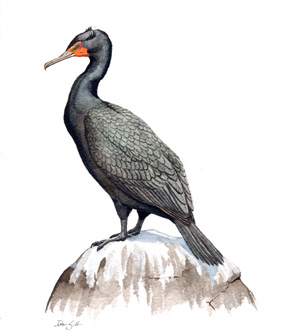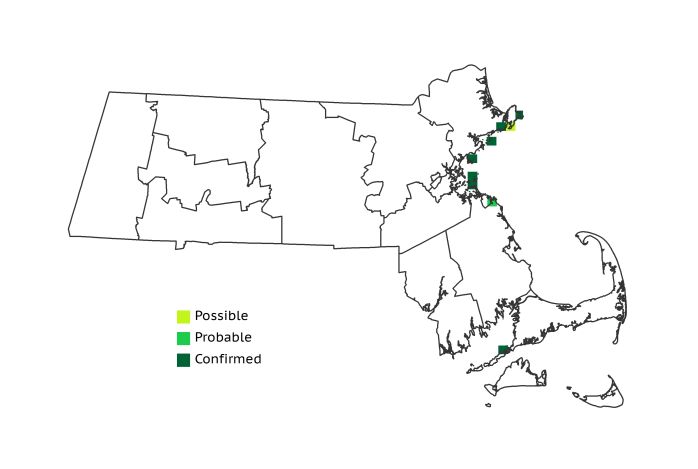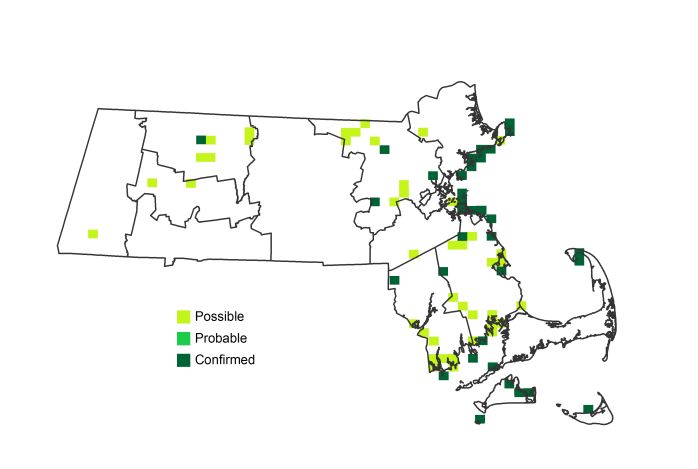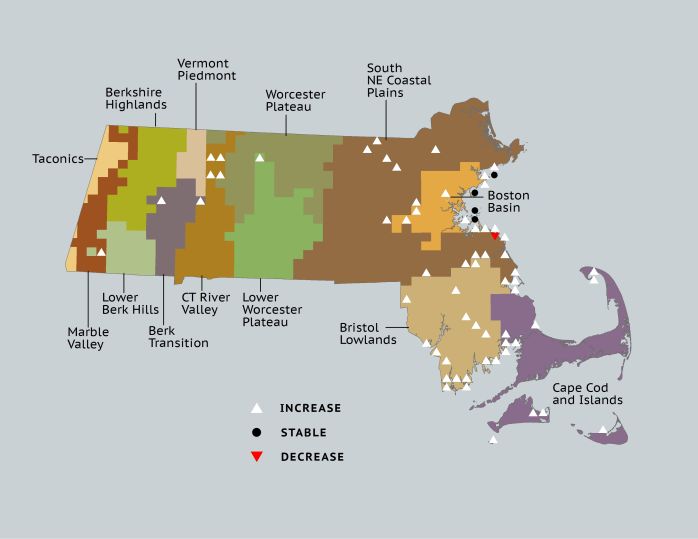Breeding Bird Atlases (BBA)
Find a Bird
Double-crested Cormorant
Phalacrocorax auritus

Local and strongly increasing
“Thence up he flew, and on the Tree of Life, / The middle Tree and highest there that grew, / Sat like a cormorant…” – John Milton, “Paradise Lost”
Long reviled as dirty and gluttonous birds, Double-crested Cormorants were persecuted to the point of extirpation from the Commonwealth in the nineteenth century. Never a bird to be kept down, however, Double-crested Cormorants returned to Massachusetts in the 1940s and have since reestablished themselves as a breeding species. Cormorants are adroit swimmers and masterful divers, pursuing fish below the surface with great speed and agility. They nest on rocky offshore islands, either directly on the ground, in dead or live trees, and even on human-made structures.
Historic Status
Not to be mistaken for their larger winter counterparts, the Great Cormorant, Double-crested Cormorants spent many years seemingly avoiding Massachusetts. Extirpated as supposed fisheries pests, for many years they nested as nearby as Maine, only passing along the coast of the Bay State high in the sky in V-formations during migration. The demographic history of the Double-crested Cormorant in the twentieth century was marked by a growth spurt from the 1920s to the 1950s in the wake of the Migratory Bird Treaty Act of 1918; a midcentury decline resulting from increased pesticide usage; and a recovery following the 1970s (Hatch & Weselow 1999). By the early 1980s, the Massachusetts population had grown to 5,173 nesting pairs (Hatch 1982).
Atlas 1 Distribution
Like so many other colonial piscivorous species in Massachusetts, Double-crested Cormorants were entirely restricted to coastal areas during Atlas 1. The recovering population had not yet reached any inland locales, preferring to locate their vulnerable colonies on rocky offshore islands well out of reach of humans and other mammalian predators. Atlas 1 colonies were concentrated mostly along the North Shore of the Coastal Plains, close to apparent source populations in northern New England. A few colonies were also known to exist on the Harbor Islands of the Boston Basin, and one colony was recorded on the Weepecket Islands in the Cape Cod and Islands region. Since Double-crested Cormorants were no longer legally persecuted and shot as pests and threats to public health, they soon began to expand following the solid foothold initiated in the 1940s.
Atlas 2 Distribution and Change
The slow but steady growth of the Double-crested Cormorant as a breeder in Massachusetts continued in the inter-Atlas years, and also included a surprising twist. Not content to just breed along the coast, the species moved inland, and was Confirmed as far west as Franklin County, in addition to being noted during the breeding season in the Marble Valleys. The species also strengthened its foothold around the Boston Harbor area; reached the South Coast, Nantucket, and Martha’s Vineyard; and sporadically injected itself into the Lower Worcester Plateau, the Southern New England Coastal Plains, and the Bristol/Narragansett Lowlands.
Atlas 1 Map

Atlas 2 Map

Atlas Change Map

Ecoregion Data
Atlas 1 | Atlas 2 | Change | ||||||
Ecoregion | # Blocks | % Blocks | % of Range | # Blocks | % Blocks | % of Range | Change in # Blocks | Change in % Blocks |
Taconic Mountains | 0 | 0.0 | 0.0 | 0 | 0.0 | 0.0 | 0 | 0.0 |
Marble Valleys/Housatonic Valley | 0 | 0.0 | 0.0 | 1 | 2.6 | 1.3 | 1 | 2.6 |
Berkshire Highlands | 0 | 0.0 | 0.0 | 0 | 0.0 | 0.0 | 0 | 0.0 |
Lower Berkshire Hills | 0 | 0.0 | 0.0 | 0 | 0.0 | 0.0 | 0 | 0.0 |
Vermont Piedmont | 0 | 0.0 | 0.0 | 0 | 0.0 | 0.0 | 0 | 0.0 |
Berkshire Transition | 0 | 0.0 | 0.0 | 2 | 5.0 | 2.6 | 2 | 6.5 |
Connecticut River Valley | 0 | 0.0 | 0.0 | 4 | 6.2 | 5.2 | 4 | 8.3 |
Worcester Plateau | 0 | 0.0 | 0.0 | 1 | 1.1 | 1.3 | 0 | 0.0 |
Lower Worcester Plateau | 0 | 0.0 | 0.0 | 1 | 1.3 | 1.3 | 1 | 1.9 |
S. New England Coastal Plains and Hills | 5 | 1.9 | 55.6 | 25 | 8.8 | 32.5 | 17 | 7.5 |
Boston Basin | 3 | 5.4 | 33.3 | 11 | 19.6 | 14.3 | 8 | 14.5 |
Bristol and Narragansett Lowlands | 0 | 0.0 | 0.0 | 19 | 16.7 | 24.7 | 17 | 16.8 |
Cape Cod and Islands | 1 | 0.7 | 11.1 | 13 | 9.0 | 16.9 | 11 | 9.2 |
Statewide Total | 9 | 0.9 | 100.0 | 77 | 7.4 | 100.0 | 61 | 7.4 |
Notes
Breeding Bird Survey data affirmed trends seen in the Atlas data. In addition to the success of their inland ventures, Double-crested Cormorants are clearly on the increase along the coast. However, old prejudices die hard, and new concerns have been added to the old. Organized aquaculture operations that raise fish for food and river and lake stocking can lose a substantial portion of their crop to hungry cormorants, and even certain environmental groups are concerned over the species’ tendency to drown its own nesting grounds in ammonium nitrate-rich feces. New control programs are being nationally instituted (including in New England), which are aimed at keeping the numbers of Double-crested Cormorants in check. If this species has proven anything, however, it has demonstrated its resilience and its ability to prosper even in the face of long-standing adversity.



